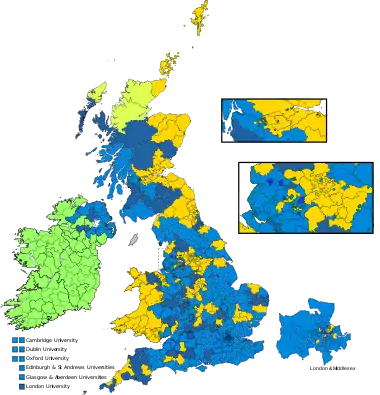| |||||||||||||||||||||||||||||||||||||||||||||
All 670 seats in the House of Commons 336 seats needed for a majority | |||||||||||||||||||||||||||||||||||||||||||||
|---|---|---|---|---|---|---|---|---|---|---|---|---|---|---|---|---|---|---|---|---|---|---|---|---|---|---|---|---|---|---|---|---|---|---|---|---|---|---|---|---|---|---|---|---|---|
| Turnout | 74.2% | ||||||||||||||||||||||||||||||||||||||||||||
| |||||||||||||||||||||||||||||||||||||||||||||
 Colours denote the winning party | |||||||||||||||||||||||||||||||||||||||||||||
| |||||||||||||||||||||||||||||||||||||||||||||
The 1886 United Kingdom general election took place from 1 to 27 July 1886, following the defeat of the Government of Ireland Bill 1886. It resulted in a major reversal of the results of the 1885 election as the Conservatives, led by Lord Salisbury, were joined in an electoral pact with the breakaway Unionist wing of the Liberals led by Lord Hartington (later the Duke of Devonshire) and Joseph Chamberlain. The new Liberal Unionist party elected 77 members and gave the Conservatives their parliamentary majority, but did not join them in a formal coalition.
William Ewart Gladstone's Liberals, who supported the Irish Home Rule movement, and their sometimes allies the Irish Parliamentary Party, led by Charles Stewart Parnell, were placed a distant second. The split in the Liberal Party ended the period of Liberal dominance. They had held power for 18 of the 27 years since 1859 and won five of the six elections held during that time, but would only be in power for three of the next nineteen years. This was also the first election since the 1841 election that the Conservatives won a plurality or majority of the popular vote.
Results

| Candidates | Votes | ||||||||||
|---|---|---|---|---|---|---|---|---|---|---|---|
| Party | Leader | Stood | Elected | Gained | Unseated | Net | % of total | % | No. | Net % | |
| Conservative and Liberal Unionist | Lord Salisbury | 563 | 393 | 161 | 14 | +146 | 58.66 | 51.40 | 1,417,627 | +8.7 | |
| Liberal | William Ewart Gladstone | 449 | 192 | 24 | 152 | −127 | 28.66 | 45.13 | 1,244,683 | −2.2 | |
| Irish Parliamentary | Charles Stewart Parnell | 100 | 85 | 1 | 2 | −1 | 12.69 | 3.41 | 94,050 | −3.4 | |
| Independent Liberal | N/A | 1 | 0 | 0 | 0 | 0 | 0 | 0.05 | 1,247 | ||
| Ind. Liberal Unionist | N/A | 2 | 0 | 0 | 0 | 0 | 0 | 0.02 | 544 | ||
Vote summary
Seats summary
See also
References
- Craig, F. W. S. (1989), British Electoral Facts: 1832–1987, Dartmouth: Gower, ISBN 0900178302
- Rallings, Colin; Thrasher, Michael, eds. (2000), British Electoral Facts 1832–1999, Ashgate Publishing Ltd
Further reading
- Blaxill, Luke. From: The War of Words: The Language of British Elections, 1880–1922 (2020) pp. 81–123.
- Roberts, Matthew. "Election Cartoons and Political Communication In Victorian England.' Cultural & Social History (2013) 10#3 pp 369–395, covers 1860 to 1890.
- Walker, Brian (2005), "The 1885 and 1886 General Elections in Ireland", History Ireland, 13 (6): 36–40, JSTOR 27725365
References
- ↑ "General Election Results 1885-1979". Archived from the original on 30 January 2012. Retrieved 14 February 2023.
.jpg.webp)
.jpg.webp)
